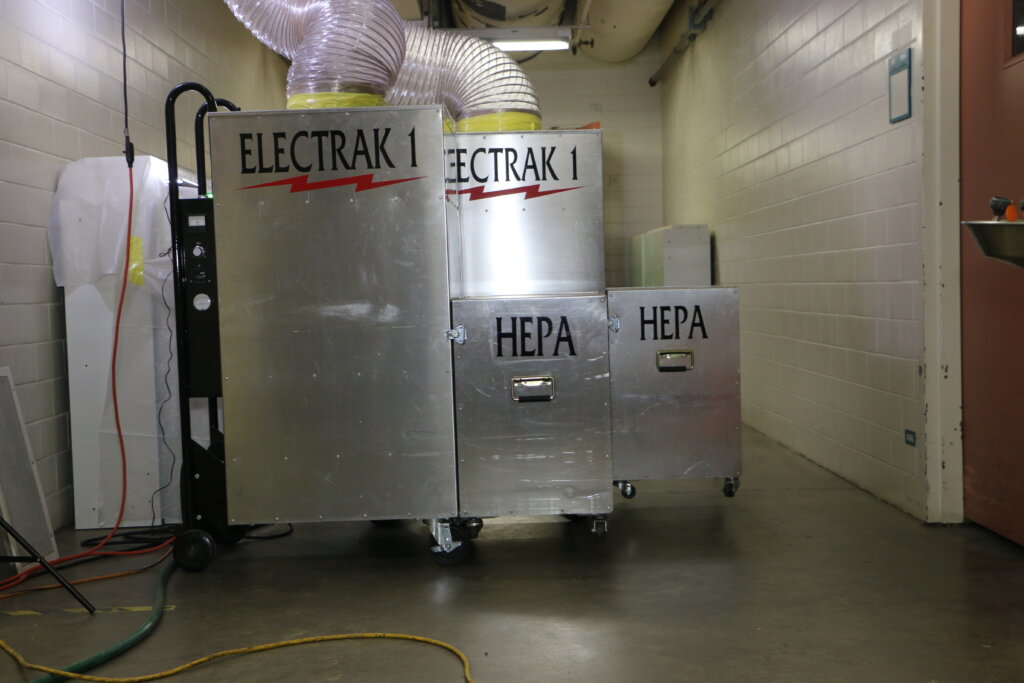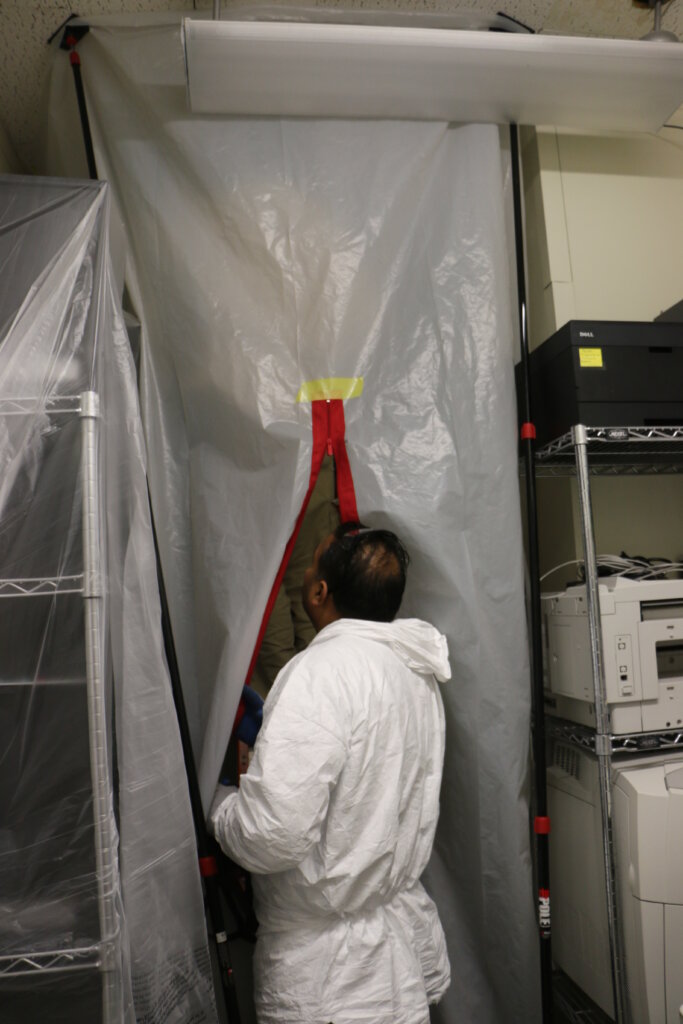By Bob Krell, CIEC, CMRS, LEED-AP, NYS Mold Assessor —
This article is about DUCT cleaning, not duck cleaning!
OK, I just couldn’t resist the graphic puns, but after over 27 years of being involved in the HVAC hygiene industry, I think it’s fitting.
So, just what IS duct cleaning, and why should you be considering it as part of a proactive maintenance program for your home or commercial space? “Duct Cleaning” refers to the cleaning of heating, ventilation and cooling (HVAC) systems, including their associated air ducts and components. HVAC systems that supply air to occupant spaces generally incorporate some form of filtration to remove varying degrees of airborne debris and contaminants from the delivered air.
If It Has Filters, Why Do You Need to Clean It?
Here’s the thing about many of the filters being used on many of the systems out there: They’re not very good. If you can hold a clean filter up and look right through it (like with a typical 1” hardware store fiberglass variety), it isn’t stopping most of the fine particles that you’re likely concerned about breathing in. In most cases, some debris will eventually accumulate within your HVAC systems, filters or not. Many systems have their filtration located near the blower fan in the air handling unit, although some smaller residential systems have a filter located over a central return air grill instead. In any case, debris builds up over time.
The dust and debris that gets drawn into HVAC ductwork and the air handling unit itself may be compounded by moisture (both moisture that’s drawn in from the ambient environment and what is undesirably carried-over from any AC cooling coils and drain pans), as well as a deterioration of internal insulation, gasketing, and metal components. The presence of corrosive chemicals, biological contaminants, or other adverse environmental conditions can further serve to affect the hygiene of a building’s HVAC system(s) and contribute to degraded indoor air quality (IAQ).
The bottom line is: For an assortment of reasons, HVAC systems become contaminated over time, leading to potentially compromised IAQ and increased energy consumption. That said, duct cleaning represents only one piece of the indoor environmental management puzzle.
The Solution to Indoor Air Pollution?
Before he took to speaking to empty chairs, Clint Eastwood nailed it with his quote in the movie Magnum Force back in the 1970s when he said, “A man’s got to know his limitations…”
An industry’s got to know its limitations, too. Air duct cleaning will not solve all the IAQ problems in a building, despite the claims from some practitioners. It’s only one piece in the puzzle…perhaps an important one, but none-the-less, just a piece. I see this card played all the time in both the commercial and residential markets by duct cleaning service providers that are over-selling their service. Responsible, knowledgeable firms don’t make excessive benefits claims, period.
Run Away–Part 1
While I’m on that rant, if I see one more residential duct cleaning promotional piece with a picture of a dust mite in it, I’m going to lose it…seriously. It’s like another bad Kevin Bacon movie, only with the tremors in your HVAC and wallet. Cleaning your ductwork doesn’t rid your building of dust mites, since they don’t live in your ductwork! As a consumer, when you see dust mites in duct cleaning marketing–RUN AWAY! Also, when you see group-on-dupe-on ads for $49, $99, $149 or similar duct cleaning “specials” —RUN FASTER. There’s no way you can get even marginal quality service work done for these bait prices.
What Duct Cleaning Does (or at least should) Entail
Duct cleaning is somewhat of a misnomer. Unlike the term says, duct cleaning should include the entire system: Grills/diffusers, air handling unit (including fans, coils, and filter compartments), control devices (dampers, turning vanes, mixing/VAV boxes, etc.), and the ductwork.
I regularly get RFPs that only call for cleaning small portions of an HVAC system during commercial renovation projects, as if the debris intentionally confines itself to specific sections of ductwork (the same physics principals that used to keep cigarette smoke out of a restaurant’s non-smoking section?).
Partial cleaning (i.e. leaving out portions of the work) generally only yields partial benefits of having the service performed.
Does Size Matter?
With some things, perhaps, but not necessarily with duct cleaning. I became involved in the industry back in the late 1980s, when truck-mounted vacuums were pretty much the way things were done. Equipment manufacturers touted their massive CFM vacuum airflow specs. Of course, bragging about the size of your tool was nothing new in the duct cleaning industry.

Vacuum capabilities are certainly a factor for effective cleaning, but those alone do not ensure thorough contaminant removal. You see, HVAC ductwork, despite what you might have heard, is not really cleaned by sucking the dirt out! Vacuum equipment serves as the collection device for debris, once it has been dislodged via mechanical and/or pneumatic means. In lay terms, you gotta knock the junk loose so it can get vacuumed up. We’ll talk more about those methods later in the article.
Now don’t get me wrong, size does matter–a bit. You need enough flow and static pressure to control, contain and capture debris, otherwise the duct in question won’t get cleaned and unwanted contaminants may be spread throughout the rest of the system and building.
As I mentioned earlier, truck-mounted and other large portable gas or diesel engine-type vacuums used to be the only option for duct cleaning purposes. These are still extensively used for residential and light commercial service work today.
In the early 1990s, a new wave of portable electric duct cleaning vacuums were introduced. Unlike the earlier vacs that were located outdoors, these new portable units are exhausted indoors. As such, they utilize HEPA, otherwise known as High Efficiency Particulate Air filtration (99.97% efficient at 0.3 micron particle size) to minimize the possibility of cross-contamination from vacuum exhaust. Large commercial ducts sized sufficiently for technicians to enter also have commonly been cleaned by contact vacuuming with brush attachments connected to smaller HEPA-equipped shop-vac style vacuums. This technique can yield excellent results when access is available.

As a rule, the size and capacity of the vacuum collection device dictates the amount of ductwork that can be effectively cleaned from each set up point. More powerful collection equipment can potentially clean longer duct runs, but that factor alone does not always mean such equipment does a better job. HVAC systems can often be zoned-off for cleaning work to allow the effective use of smaller collection devices.
Cleaning efficacy is more dependent on the effectiveness of the agitation method and the thoroughness of the technicians performing the actual work, than the actual size of the vacuum collection unit.
So, it’s not necessarily how big it is, but how you use it (yeah, I went there…).
Not All Ducts Are Created the Same
If the systems aren’t cleaned by just sucking them out with a vacuum, how does the process work?
First, you need to realize that there are several “flavors” of air ducts. There’s bare sheet metal, sheet metal with fiberglass thermal/acoustic liner, fiberglass composite ductboard, spiral flex duct, and building interstitial spaces (suspended ceiling plenums, wall cavities, spaces between floor joists, etc.) pretending to be ductwork. The latter can be the most problematic for maintenance and cleaning, due to difficult access and the sheer volume of some of these spaces. Internally lined and ductboard systems have the added pleasure of potential deterioration and fiber release, in addition to the propensity for holding moisture and debris in their porous matrix. Yes, Virginia, fibrous internal air duct products DO break down and end up blowing out in the air stream causing issues!
The various system components like coils and air control devices also dictate specific cleaning methods. Different duct types call for different cleaning techniques. More aggressive methods can easily damage fibrous glass ducts, coil fins and gaskets, so that always must be taken into account.
Many HVAC systems use a combination of some (or all) of these duct types, which may require the need for multiple cleaning techniques on a given project.
A second consideration is the nature of the contamination in the system. Is it simply a benign form of common nuisance dust from the building, or something of greater concern such as contamination from microbiological or regulated hazardous materials like asbestos or lead? In the case of regulated materials, the HVAC cleaning procedures must defer to procedures specified by appropriate regulatory agency that governs its handling.
Another very important factor is the type of building where the HVAC system in question is located. There are significant differences in how you should handle cleaning a single-story ranch house versus a hospital operating room. While engineering controls are important for all projects, they become increasingly more critical in acute care environments. Some facilities necessitate the use of portable containment enclosures, HEPA air scrubbers for ambient air, and ongoing monitoring to ensure that the HVAC cleaning work doesn’t adversely affect the indoor environment.

Some indoor environmental engineering controls are needed on any job, and ensuring the proper measures are taken is paramount to achieving success with a project. After all, duct cleaning is likely being done to improve, not degrade the indoor environment for occupants!
You can read the full article in the October 2019 Digital Edition of Healthy Indoors Magazine at: https://hi.healthyindoors.com/i/1179928-hi-october-2019/15
The post DIRTY DUCKS? An Air DUCT Cleaning & HVAC Hygiene Primer appeared first on Healthy Indoors.






















